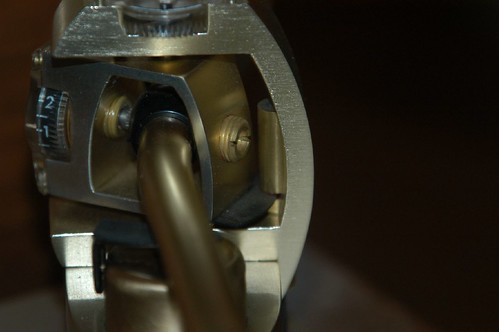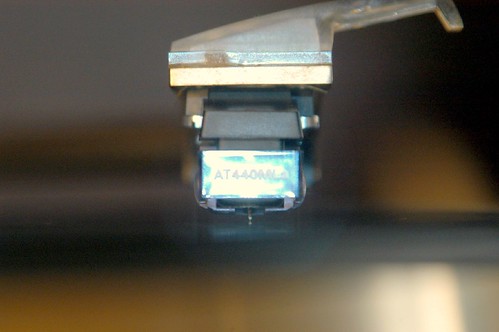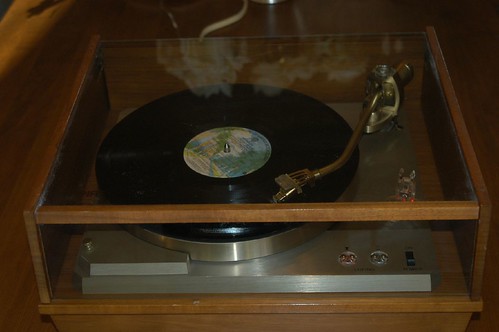Thursday, January 17, 2008
Video Review of McIntosh C220+MC252
This video review of audio components format received great feedback on the various forums so I may do a few more in the future.
Alberto
Sunday, April 22, 2007
Review: McIntosh C220 + MC252
I visited a couple of different stores that sold McIntosh to do some more listening and to make sure that my first experience was not a fluke. I brought my familiar CDs (unfortunately no stores had a turntable set-up for auditions) and listened … and listened. I listened through speakers and headphones. I listened loud and soft. I listened to classical, jazz, and rock. Unlike many of the other brands the McIntosh equipment sounded delicious on everything. I know delicious is a strange term for an audio review, but sweet, silky, and delicious are the adjectives that kept coming to mind. It was not the most detailed sound I’ve ever heard, not the fastest, or widest. It did not excel, or stand out, in any particular area - except in the one thing that I’ve now come to learn and appreciate the most – musicality.
My mind was made up. I wanted a McIntosh more than I ever wanted any other piece of audio equipment. Based on my past experience, I have come to appreciate the sound of tubes and decided to go for a tube pre and a solid-state power-amp. Taking cost and my power requirements into consideration, I bought their entry-level tube pre, the C220, and their entry-level power amplifier, the MC252. Fortunately this particular combo was discounted $1,200 from the list price, but this was the single most expensive audio purchase I ever made (almost $7,000 including taxes and a balanced cable).
It took me over one hour to unpack and install the two components. The MC252 weighs almost 100lbs. Fortunately I am in pretty good shape and I was able to handle it without breaking anything (either in my own body or in the equipment) or having to wait for a friend to come and help me. I knew those push-ups would come in handy for something.
I installed them in my system that consists of a Rega Apollo CD player, a wonderful Thorens TD125mkII with SME 3009 II tonearm and Audio Technical 440mla cartridge as sources, and a pair of Quad 22L as speakers. I used relatively inexpensive AudioQuest interconnects and my speakers are bi-wired with heavy-gage (10 – I believe) homemade cables. Just to be safe I burned them in for a week playing them 6-8 hours a day.
Below is my review after the burn-in period. I am going to focus mainly on the sound since you can read about the various features and specs on the McIntosh website.
Even though the C220 is McIntosh entry-level amplifier, it has the same great looks, fit-and-finish, and smooth operations of its more expensive brethren. The sound is not the only think that’s silky smooth about this pre. The volume control, for example, is a pleasure to use; it turns frictionlessly and is tuned to provide exquisitely fine control over the volume. The input selector switch is programmable (i.e. you can skip inputs that are not connected and rename inputs) and equally pleasant to operate. The pre is dead silent; no nasty pops or clicks as I switch between inputs.
Rather unique these days, and definitely one of the deciding factors in choosing the C220 is that it has a built in tube phono stage for a moving-magnet or high-output moving coil cartridge. I could not audition it at the store and I was prepared to use an outboard phono stage, but I was very pleasantly surprised by how great the built-in sounded.
I was also very impressed by the built-in headphone amplifier (although I would have preferred a ¼” jack instead of the mini jack). I listen a lot in the early morning and late night (while the family is sleeping) and having a good headphone amp is a must for me. As with the phono stage, I don’t feel the need to have an outboard unit.
The MC252 power-amp is a gorgeous looking piece of equipment too. Those lovely baby blue eyes (the VU meters that have become a McIntosh trademark) make you want to put the power-amp on display instead of hiding it somewhere.
The speakers connectors in the back are top quality and the most flexible and easiest to use I have experienced so far. I used a balanced cable to connect the pre to the power-amp, but you can also use unbalanced RCA cable. The pre can turn the power-amp on/off by connecting them with a small mini-jack cable.
Sometimes, equipment that sounds great in the store does not sound as good once you bring it home. No worries here. The sound that captivated me was all there in my living room.
Sound is very subjective and difficult to describe, so I leave a more detailed description to professional reviewers, so I will summarize it as follows: Warm, but not too warm, with the right amount of detail and dynamics. The lows are tight and controlled, and the highs have a lot air. The overall impression is one of naturalness, nothing is strained, and everything feels effortless. I don’t know for a fact what the McIntosh engineers are aiming for when designing and tuning their creations, but I would not be surprised if their primary objective is to find the right balance of attributes that results in the kind of sound that you can listen to for hours. A sound that can take advantage of great source material but is also very forgiving of less than perfect recordings. Thanks to McIntosh I rediscovered 80% of my CD and record collection.
Ultimately, audio equipment is for listening to and enjoying music. So my most important criteria for judging components is whether I am enjoying the way they sound, which I can measure somewhat objectively by how much time I spend listening to music and whether after a while I feel like giving my ears a break or listen some more. Since adding the C220 and MC252 to my system, my listening has gone into overtime. Turning them off to go to work, or to dinner, or to bed, takes effort and will power.
Since I listen to a lot of music these days, I need to protect my hearing and listen at reasonably low volume most of the time. Despite its 250WPC rating, the MC252 works great even when putting out a fraction of a watt. More importantly, I weaned myself off the need for using loudness or other forms of equalization to make up for low-level listening. I get more enjoyment at 60db with these components than with anything else I have used. In the past, I used to listen to one or two tracks, then get up to find another record. With the McIntosh I find myself listening to records from beginning to end more than I ever have before.
After a few weeks of living with my new system, I feel I have found the sound that I’ve been looking for in all these years of swapping and upgrading components. I would have never guessed that it would have taken this form, or that would have come from McIntosh. I have said this before, and I have proved myself wrong, but this time I really believe I have found a system I can live with for many years to come. I have learned how much I value musicality, the ability to listen at length, and to be able to include less-than-perfect recordings in my listening sessions.
If you have the same pre-conceived notions about McIntosh equipment that I had, I strongly encourage you to go and listen to their new components. Some of you may still prefer a more “audiophile”, faster, more etcher or detailed, sound, but I have to believe that many of you will experience the same epiphany I had.
Hope you enjoyed this non-professional review.
Alberto
P.S. I realize that with my speakers (Quad 22Ls) I am now violating one of the cardinal rules of spending most of your audio budget on speakers. I also realize that my sources (Rega Apollo and Thorens TD125) might no longer be up to par with my amplification. Eventually I will upgrade some the other components, but since - even my current speakers and sources - I am able to capture the essence and sweetness of the sound I heard at the store, I am in no hurry.
Review: Empire 398
 |
| From Empire 398 |
My review, and opinion, is based on my previous experience restoring and using two other turntables from the same vintage: a Thorens TD124 mkI and a mkII, both with SME 3009 II tonearms.
Here's one of my Thorens:
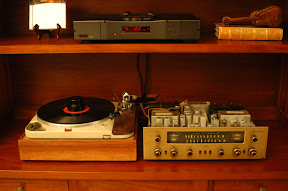 |
| From McIntosh + Vi... |
I'll start with the first impression which was visual. I believe the Empire turntable is much better looking than the Thorens. Especially the way I have it set-up right next to a gold-faced Fisher 600 from the same vintage.
 |
| From Empire 398 |
Compared to the SME 3009, the Empire tonearm looks like a part from a transmission, but I find it attractive in a very retro way.
 |
| From Empire 398 |
With the new belt, speed was within 0.2% of 33 1/3 - yeah!!
The platter spins evenly and is dead quiet. The motor on the other hand emits an audible "white noise", but not too disturbing. Very, very, little vibration is transmitted from the motor to the chassis.
I LOVE the fact that the platter comes up to speed, and stays at the right speed in a couple of seconds. The TD124s took their time and were very subject to the vagaries of the AC.
Having to use the shell-adapter to mount the cartridge has advantages and disadvantages. It's easier to mount a cart, but the way it's attached to the arm with a big screw is a bit clunky. It would be great if spare adapters were not so hard to find.
I mounted a Shure M97XE since inmates said that my favorite budget cart (AT440mla) would not play well with the Empire 980 tonearm.
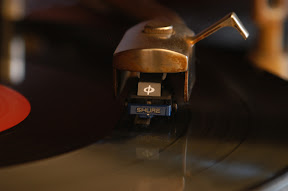 |
| From Empire 398 |
I did the set-up using the HiFi News test record and the Shure VTF scale (and various other little tools like a mirror overhang adjuster).
After some experimenting, I set the VTF to 2.0gm with the Shure brush down. With this set-up tracking was OK on the first 2 tracking torture tests on the test LP.
No antiskate to adjust ... one less thing to worry about :-).
One of the things I noticed while testing the tracking, and the only thing that's bugging me a bit and I want to try to track down and fix, is that the 300Hz and 1Khz tones on the test LP modulate (like a vibrato or tremolo) a little bit with a frequency between 1 and 2hz. I don't know how to describe it better except that the tone are not rock solid. Sounded a bit like standing waves reinforcing/cancelling but since I can also hear it on the headphones is probably not a room problem. ANY HELP/HINT FROM INMATES ON THIS WOULD BE GREATLY WELCOME.
The resonating frequency tests show very low (sub 10) resonating frequency. I tried putting a small amount of blue tack to change the effective mass but it do not do much - I did not have too much time to do a lot of trying. Could the resonating frequency be related to the modulation problem.
Finally I put away the test disk and played some music.
I am not a huge fan of the M97XE (since I've had my 440mla) but now, with the speed problem gone, the turntable makes some warm and nice music that I really enjoyed listening to.
When I bought this table I was not after high-end sound - after all it's matched with a 45 year-old receiver - but a warm soothing sound and a great vintage look. I believe I got those in spades. I love the way my birthday system (i.e. the system as old as I am) looks and - as long as I don't compare to my main system and keep my expectations at the right level - I really enjoy listening to it.
I hope you found this review and the pics interesting. If you are into vintage turntables, the Empires are definitely worth a look and a listen. Great addition to my collection.
If you have hints or suggestions for the tremolo/vibrato problem, please let me know.
Thanks,
Alberto
Review: Empire 698 Vintage Turntable
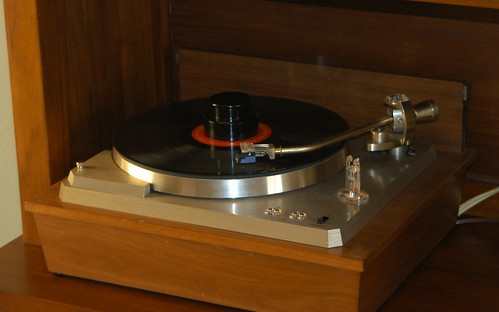
I bought this Empire 698 from an ad on craigslist for $400. I believe that the ad was up for a few days and I must have been the first and only caller based on the eagerness of the seller when I called. I already have an Empire 398 and 3 Thorens (TD124mkI, TD124mkII, TD125mkII) so I needed another vintage turntable like my wife needs another pair of shoes. But the craigslist ad said that the table was mint, and the seller agreed to drive it to my home (~1hr drive) to see it if I was willing to pay $20. I thought it was worth a shot since I had never seen a 698 in the “flesh”.
The guy arrived and, much to my surprise, he knew enough to take the table apart for shipping. We reassembled it and it looked great. The only problems were some nicks and notches in the wood plinth and cover. Everything else looked mint as advertised.
Let me start by saying that this is truly a MAGNIFICENT looking piece of machinery. Aesthetically, it’s a combination of modern, classical, and sci-fi. It would look right at home a movie like “Dune” or “The Fifth Element” – if you’ve seen either you probably know what I mean. Given the broad combination of materials used, the result could have been horrendous. Consider that it has a gold-tone metal chassis, platter, and tonearm, a clear plexiglass tonearm rest (illuminated from below with a red LED), clear plastic touch sensitive switches (also illuminated from below with a red LED) for cueing, a black plastic on/off switch, a wood plinth, and a wood and smoked-glass cover.
Unlike my TD124s which required quite a bit of care, restoration (e.g. they both leaked oil and needed a new gasket), and more modern tonearm (SME 3009II), all this Empire required was a little bit of dusting.
Set-up was a breeze. The seller gave me the original instructions, which came in poster form, and were very well written – the best I’ve read for a turntable set-up. I like to use a weight stabilizer so I adjusted the suspension wing-nuts to have the platter float approximately 1/8” off the base with the weight on. Took me five minutes to get it where I wanted it to be. I installed my favorite budget cartridge (AT440mla) on the removable head-shell and used the HiFi News Test LP (HFN TLP) to set overhang, and make sure all the wiring was correct and to find the best VTA, VTF, and anti-skating settings. There is a strobe disk in the center of the platter and, with a portable fluorescent light, setting the correct speed was a piece of cake. All and all, I must have spent 30-40 minutes to get the set-up right – and had fun doing it because everything responded so well and was very intuitive. The only thing that did not work well was the lowering of the tonearm using the cueing button – it looks like it needs some lubrication – but I could not wait to listen so I postponed that task.
As usual, the AT440mla did splendidly in the HFN TLP, passed the tracking torture tests with flying colors (what an amazing cartridge for $89). Both the vertical and horizontal resonance tests on the test LP came in at 9Hz, a bit low, but acceptable.
Enough testing, time to play some real music…
I planned to use this table on my vintage system which consists of a Fisher 600 receiver (from 1960) and a pair of Tannoy Prestige Mini speakers (with dual-concentric drivers). This system gives me at least as much pleasure as my fancy-pants McIntosh/Quad set-up in the living room.
I know that the 440mla has to break in for 40-50 hours (I have two of them already in use), but it sounded darn good from the start – amazing in-fact. It’s probably because my expectations for the 698 were lower than those for the Thorens/SME combos, but I was floored by what I heard – great sound stage, deep bass, crystalline highs, spot-on and rock solid speed. No way this is a $400 table with an $89 cart! I may not have golden ears, but those of you who are familiar with my other postings knows that I am quite picky and not that easy to please (e.g. my recent issues with the 398 speed and modulation problems). This table/cartridge sang to me like no other table I’ve owned (modern or vintage). It sounds the way it looks – warm, rich, golden – the kind of sound I am a sucker for. I played rock, jazz (vocal and instrumental), and classical; all came through vivid and three-dimensional. “Ella at Duke’s Place” sounded better than I’ve ever heard it. Joe Pass’s nylon strings guitar on Joe Pass’s “I Remember Charlie Parker” sounded just like it should – all picking noises, incidental sounds, coming through with great realism. I could go on, but the bottom-line is that whatever I threw at this table/cart sounded great and dragged me in the music. It was very hard to turn it off when I had to go to bed.
Many vintage fans think that Empires are underrated tables – and I fully agree with that. But the common wisdom is also that the earlier non-suspended Empires like the 208 and 398 are better tables than the later suspended models like the 598 and the 698 – and I am not sure I agree with that. It might be possible that with a lot of tweaking (e.g. a massive plinth, new tonearm, etc.) a 208 or 398 might sound better than a 698 but based on my experience with both tables, out of the box, the 698 by far the better performer with rock-solid speed, very low noise floor, and a very good tonearm. I found that with the right cartridge it holds its own against more venerated suspended tables like the Thorens and ARs – and looks tons better than both IMO.
In summary, the Empire 698 surprised the heck out of me. I was prepared to like it and keep it for its looks, but not to love the looks AND the sound as much as I did. It may not be the table for you if you like the cold looks and analytic sound of most modern (plexiglass, plastic, and shiny steel) turntables, but if you dig vintage gear and warm analog/tube sound the Empire is definitely worth considering.
For those people who are looking for a starter table/cart for under $500 to get into vinyl, I can’t imagine a better deal than a 698 with AT440mla – especially since it’s so easy to set-up and requires no restoration (other than a new belt).
I hope you enjoyed this review. It took me a while to write, but I felt an obligation to be thorough and share my finding with other vinyl/vintage enthusiasts since so much has been written about vintage Thorens/Garrards/Lencos and so little about Empires. I believe these tables deserve much more visibility and respects than they’ve been given. The combination of build-quality, features, looks, and sound makes them an AMAZING deal for the prices they are demanding these days.
Alberto

